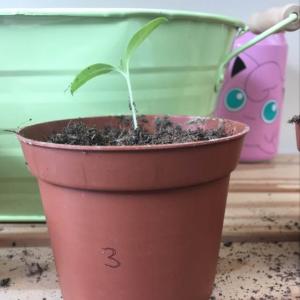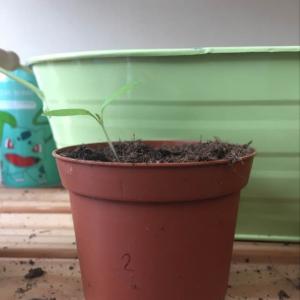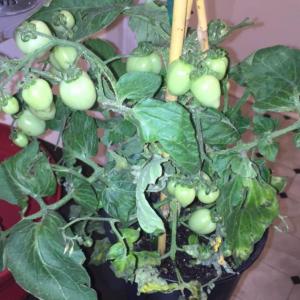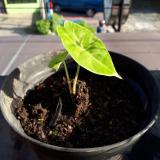成长记
chingleng/otter
2018年01月17日

I now added "Tomato(IDENTIFY)" in my "garden"
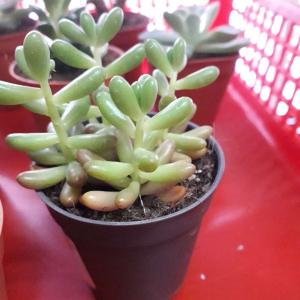

1
0
meriunkat:Sedum Rubrotinctum "Jellybean"
文章
Miss Chen
2017年11月26日

Mushrooms are a wild plant that can be delicious when added to salads or tomato sauce, but not all mushrooms are safe to eat. If you live in the Maryland area, it may be tempting to pick mushrooms you find growing in your yard or in a wooded area nearby, but this may not be safe, depending on the species you find. Identifying species of mushroom found in Maryland can help prevent accidental poisoning.

Black-footed Polypore
Black-footed polypores are usually found on decaying deciduous wood between August and December. They grow individually or in groups. These mushrooms are easily identifiable. The caps are usually between 1 1/2 and almost 8 inches wide and are dark reddish-brown. The color gets paler toward the edges. Black-footed polypores are inedible. Their scientific name is Polyporus badius.
Autumn Skullcap
Autumn skullcaps have small caps, which are usually only 1 1/2 to 2 1/2 inches across. They can be found in forests or natural areas, usually on rotted wood. They grow individually or in small clusters. The autumn skullcap, which is also called the deadly Galernia, is poisonous if ingested. In fact, they are so toxic that they can be fatal if eaten. The scientific name of the autumn skullcap is Galernia autumnalis.
Honey Mushroom
The honey mushroom is usually found at the base of deciduous trees or pines or on old stumps. In some cases, the mushrooms behave as parasites by living on live shrubs or trees. The individual caps can grow up to 4 inches across and the stalks are about 3/4 inches wide, and can grow up to 6 inches high. True honey mushrooms are edible, but some people's stomachs can be upset by them. There are also poisonous mushrooms that are very similar in appearance. The scientific name for the honey mushroom is Armillariella mellea.
Crown-tipped Coral Fungus
These mushrooms look like coral found on the ocean floor, and grow on logs that are well decayed. They are common, and edible, either raw or cooked. The scientific name of these mushrooms is Clavicorona pyxidata. This particular mushroom is only one type of Clavicorona mushrooms.

Netted Rhodotus
The netted Rhodotus are usually found between June and September on dead deciduous wood, either scattered or in groups. The caps of these mushrooms are 1 to 2 inches across. They are red or pink with white ridges that look like netting over the caps. The stalks are around 1 to 2 inches thick and measure 1 to 2 inches long. Netted Rhodotus are not a common type of mushroom, and it's unknown if they're edible. The scientific name of the netted Rhodotus is Rhodotus palmatus.

Black-footed Polypore
Black-footed polypores are usually found on decaying deciduous wood between August and December. They grow individually or in groups. These mushrooms are easily identifiable. The caps are usually between 1 1/2 and almost 8 inches wide and are dark reddish-brown. The color gets paler toward the edges. Black-footed polypores are inedible. Their scientific name is Polyporus badius.
Autumn Skullcap
Autumn skullcaps have small caps, which are usually only 1 1/2 to 2 1/2 inches across. They can be found in forests or natural areas, usually on rotted wood. They grow individually or in small clusters. The autumn skullcap, which is also called the deadly Galernia, is poisonous if ingested. In fact, they are so toxic that they can be fatal if eaten. The scientific name of the autumn skullcap is Galernia autumnalis.
Honey Mushroom
The honey mushroom is usually found at the base of deciduous trees or pines or on old stumps. In some cases, the mushrooms behave as parasites by living on live shrubs or trees. The individual caps can grow up to 4 inches across and the stalks are about 3/4 inches wide, and can grow up to 6 inches high. True honey mushrooms are edible, but some people's stomachs can be upset by them. There are also poisonous mushrooms that are very similar in appearance. The scientific name for the honey mushroom is Armillariella mellea.
Crown-tipped Coral Fungus
These mushrooms look like coral found on the ocean floor, and grow on logs that are well decayed. They are common, and edible, either raw or cooked. The scientific name of these mushrooms is Clavicorona pyxidata. This particular mushroom is only one type of Clavicorona mushrooms.

Netted Rhodotus
The netted Rhodotus are usually found between June and September on dead deciduous wood, either scattered or in groups. The caps of these mushrooms are 1 to 2 inches across. They are red or pink with white ridges that look like netting over the caps. The stalks are around 1 to 2 inches thick and measure 1 to 2 inches long. Netted Rhodotus are not a common type of mushroom, and it's unknown if they're edible. The scientific name of the netted Rhodotus is Rhodotus palmatus.
0
0
文章
Miss Chen
2017年11月25日

The tomato (Solanum lycopersicum) is a summer vegetable in the nightshade family. All tomatoes fall into one of two categories: determinate or indeterminate. Determinate tomatoes only grow to a certain size and produce a certain number of fruits, depending on the variety. Indeterminate tomatoes continue to grow vines and produce fruit for as long as conditions are favorable. Regardless of the difference in growth patterns, all tomatoes must be fertilized and are susceptible to the same pests, disease and frost damage.

Tomato Characteristics
Tomatoes come in many shapes, sizes and colors. Tomato sizes are characterized by weight and fall into three categories: beefsteak, cherry and grape. Beefsteak tomatoes can grow quite large at over 16 ounces, while small grape tomatoes mature to as little as 2 ounces. Some tomatoes are perfectly round while others, like roma varieties, are long and narrow, similar to a pepper. Oxheart varieties are heart-shaped with a pointed blossom end. Tomato colors include a wide range from white to black. Red and pink are the most common options, but purple and black varieties have gained popularity, particularly in specialty markets. Other colors include yellow, orange, green and various colors of stripes.
All tomato plants have green leaves and stems. Some small determinate patio varieties reach a maximum of 1- to 2-feet tall, while some indeterminate varieties can grow vines over 12-feet long in one growing season. Always read the plant description carefully before making a decision on variety.
Watch for Spring Frosts
Frost will kill a tomato plant, so have a plan in place in case there is a chance of a late spring frost after seedlings have been planted. Cut the bottom off milk jugs to create a mini-greenhouse to provide frost protection on a chilly late-spring night.
Because tomatoes are generally grown as annuals throughout the U.S. -- though they can be grown as tender perennials in -- all fruits should be harvested before the first expected frost in the fall.

Fertilization and Water Needs
Tomatoes are heavy feeders. After transplanting young seedlings, apply 1 tablespoon of 10-10-10 granular fertilizer per plant. With a rake, work it into the top few inches of soil in a circle all the way around the plant, out to 1 foot from the stem. Do not go deep enough to damage plant roots.
When the first tomatoes have reached the size of golf-balls, or reach half their mature size for smaller varieties, add 1 tablespoon of 10-10-10 fertilizer per plant again. Reapply fertilizer three weeks later, and again after another three weeks.
Always water thoroughly after fertilizing and make sure fertilizer does not touch leaves or stems. Do not apply fertilizer to plants that are stressed due to drought or heat.
Water plants any time the soil is dry 1-inch below the soil surface. Infrequent, thorough watering is better than frequent light watering because this allows water to reach plant roots more effectively.
Support and Pruning
Small, determinate tomato varieties can be sufficiently supported by tying the main stem to a stake or using a standard three-ring tomato cage. Larger indeterminate varieties require more significant support. Make a sturdy, long-lasting tomato cage out of concrete remesh, available in sheets from many home improvement stores.
Determinate varieties should not be pruned unless they have damaged branches, which should be removed 1/4-inch from the main stem with sharp, sterilized pruning shears -- sterilize tools with an alcohol wipe between cuts to prevent the spread of disease. Indeterminate varieties benefit from some pruning, especially if they outgrow their supports. Remove overgrown branches as needed to prevent broken stems due to fruit that is too heavy to support.
Managing Pests
Aphids are tiny white or green insects that cover leaves, stems and blooms. Knock aphids off of tomato plants with a shot of water from a hose. If a severe infestation occurs, spray ready-to-use insecticidal soap once per day as needed, thoroughly covering all leaves and stems.
Hornworms are thick caterpillars that grow to about 4 inches long. These pests can eat all the leaves off tomato plants overnight. Remove hornworms by picking them off plants as soon as they are seen. For a severe infestation of hornworms, apply a solution of Bacillis thuringiensis to the leaves of tomato plants in the evening; mix about 1 tablespoon Bt per gallon of water, but always follow your brand's label instructions. Reapply each night as long as hornworms are present. Store Bt out of reach of children and pets.
Banishing Blight
Tomatoes are not particularly prone to disease, but yellow and brown leaves close to the ground may indicate blight. The only way to control blight is to remove damaged leaves as soon as they are visible. Burn leaves or put them in the garbage. Never compost diseased leaves. To prevent blight, select a blight-resistant variety and practice crop rotation by planting tomatoes in a different spot each year.

Tomato Characteristics
Tomatoes come in many shapes, sizes and colors. Tomato sizes are characterized by weight and fall into three categories: beefsteak, cherry and grape. Beefsteak tomatoes can grow quite large at over 16 ounces, while small grape tomatoes mature to as little as 2 ounces. Some tomatoes are perfectly round while others, like roma varieties, are long and narrow, similar to a pepper. Oxheart varieties are heart-shaped with a pointed blossom end. Tomato colors include a wide range from white to black. Red and pink are the most common options, but purple and black varieties have gained popularity, particularly in specialty markets. Other colors include yellow, orange, green and various colors of stripes.
All tomato plants have green leaves and stems. Some small determinate patio varieties reach a maximum of 1- to 2-feet tall, while some indeterminate varieties can grow vines over 12-feet long in one growing season. Always read the plant description carefully before making a decision on variety.
Watch for Spring Frosts
Frost will kill a tomato plant, so have a plan in place in case there is a chance of a late spring frost after seedlings have been planted. Cut the bottom off milk jugs to create a mini-greenhouse to provide frost protection on a chilly late-spring night.
Because tomatoes are generally grown as annuals throughout the U.S. -- though they can be grown as tender perennials in -- all fruits should be harvested before the first expected frost in the fall.

Fertilization and Water Needs
Tomatoes are heavy feeders. After transplanting young seedlings, apply 1 tablespoon of 10-10-10 granular fertilizer per plant. With a rake, work it into the top few inches of soil in a circle all the way around the plant, out to 1 foot from the stem. Do not go deep enough to damage plant roots.
When the first tomatoes have reached the size of golf-balls, or reach half their mature size for smaller varieties, add 1 tablespoon of 10-10-10 fertilizer per plant again. Reapply fertilizer three weeks later, and again after another three weeks.
Always water thoroughly after fertilizing and make sure fertilizer does not touch leaves or stems. Do not apply fertilizer to plants that are stressed due to drought or heat.
Water plants any time the soil is dry 1-inch below the soil surface. Infrequent, thorough watering is better than frequent light watering because this allows water to reach plant roots more effectively.
Support and Pruning
Small, determinate tomato varieties can be sufficiently supported by tying the main stem to a stake or using a standard three-ring tomato cage. Larger indeterminate varieties require more significant support. Make a sturdy, long-lasting tomato cage out of concrete remesh, available in sheets from many home improvement stores.
Determinate varieties should not be pruned unless they have damaged branches, which should be removed 1/4-inch from the main stem with sharp, sterilized pruning shears -- sterilize tools with an alcohol wipe between cuts to prevent the spread of disease. Indeterminate varieties benefit from some pruning, especially if they outgrow their supports. Remove overgrown branches as needed to prevent broken stems due to fruit that is too heavy to support.
Managing Pests
Aphids are tiny white or green insects that cover leaves, stems and blooms. Knock aphids off of tomato plants with a shot of water from a hose. If a severe infestation occurs, spray ready-to-use insecticidal soap once per day as needed, thoroughly covering all leaves and stems.
Hornworms are thick caterpillars that grow to about 4 inches long. These pests can eat all the leaves off tomato plants overnight. Remove hornworms by picking them off plants as soon as they are seen. For a severe infestation of hornworms, apply a solution of Bacillis thuringiensis to the leaves of tomato plants in the evening; mix about 1 tablespoon Bt per gallon of water, but always follow your brand's label instructions. Reapply each night as long as hornworms are present. Store Bt out of reach of children and pets.
Banishing Blight
Tomatoes are not particularly prone to disease, but yellow and brown leaves close to the ground may indicate blight. The only way to control blight is to remove damaged leaves as soon as they are visible. Burn leaves or put them in the garbage. Never compost diseased leaves. To prevent blight, select a blight-resistant variety and practice crop rotation by planting tomatoes in a different spot each year.
0
0
文章
Miss Chen
2017年11月25日

Tomato plants (Lycopersicon lycopersicum) technically produce fruits, but people use the fruits as vegetables in salads and other dishes too numerous to list. Unfortunately, squirrels eat tomato fruits, too, passing up unripe green ones to eat only those that are ripe red. Foiling hungry squirrels is never simple. Tomato plants usually are grown as annuals.

Use Dogs and Cats
The old-fashioned method of letting a dog roam the garden is one way of discouraging squirrels from eating tomato fruits. They don't like cats either. Cats prey on squirrels.
Not all dogs are equal for this chore. Some dogs are squirrel specialists. For example, the American squirrel dog is bred to chase squirrels. A German pinscher is specifically bred to chase squirrels and other rodents.
Build Physical Barriers
Keep squirrels from eating your tomato fruits by covering your plants with plastic bird netting, chicken wire or hardware cloth; all of those barrier items are available at many garden supply centers. Whether or not this method is practical depends on the variety of tomato plants you grow.
Indeterminate tomatoes, including heirloom varieties, yield fruits all summer, but those plants are climbers that need to be staked. They can grow 10 to 12 feet tall, although 6 to 8 feet is more usual, hardly a size that you can easily surround with a barrier.
Determinate tomatoes, which usually bear fruits in late June, typically remain under 5 feet tall. So they are possible candidates for covering with bird netting.
Dwarf tomatoes, which are hybrid determinate cultivars, grow as low as 3 feet high and spread 3 feet wide. They are small enough to cover with bird netting or even chicken wire or hardware cloth.
Cage small determinate or dwarf tomato plants by encircling each of them with chicken wire and stringing bird netting over each one's top. Fasten the netting in place with clothespins. When you harvest your tomato fruits, simply remove the netting, and then put it back in place.

Wrap individual ripening tomato fruits with bird netting.
Use Smell, Bad and Good
Squirrels can smell predators, including dogs and cats, and avoid predator-scented areas. Collect dog or cat hair in a vacuum cleaner, or get some from a pet store. Put the hair in a nylon stocking or porous bag, and place the stocking or bag at the foot of your tomato plants. A variation of this method is to spray urine from wolves or other squirrel predators on the ground at the base of your tomato plants. Some garden supply stores offer predator urine.
Squirrels avoid the odor of blood meal, too. It is a dry powder extracted from slaughterhouse waste and sometimes is used as an organic fertilizer; it is available at plant nurseries and garden supply centers. Spread blood meal on the soil around your tomato plants, using fewer than 4 ounces of blood meal per 1 square yard. Blood meal contains high levels of ammonia and nitrogen; so do not apply more than that amount.
Combine 5 ounces bottle of hot pepper sauce and 1 teaspoon of a liquid, mild detergent with 1 gallon of water, and spray the mixture on the bases of your tomato plants. Respray the plants with the mixture every few days for two weeks while the squirrels learn to avoid your tomatoes. Also respray after it rains.
Establish a squirrel hangout with peanuts, corn, sunflower seeds and other food squirrels eat; you could even include some tomatoes in the mix. Give the squirrels water at the hangout, too. Place the hangout in an isolated spot well away from your tomatoes. If they get their fill at the hangout, they'll have no reason to raid your tomatoes.
Use Water and Motion
Install a motion-activated sprinkler that will douse the critters with water when they invade your garden.
Another option is to install pinwheels, compact disks or aluminum pie tins in your garden. They will move and flash whenever the wind blows. These items work for a while, and then squirrels get used to them and go for the garden's tomatoes.

Use Dogs and Cats
The old-fashioned method of letting a dog roam the garden is one way of discouraging squirrels from eating tomato fruits. They don't like cats either. Cats prey on squirrels.
Not all dogs are equal for this chore. Some dogs are squirrel specialists. For example, the American squirrel dog is bred to chase squirrels. A German pinscher is specifically bred to chase squirrels and other rodents.
Build Physical Barriers
Keep squirrels from eating your tomato fruits by covering your plants with plastic bird netting, chicken wire or hardware cloth; all of those barrier items are available at many garden supply centers. Whether or not this method is practical depends on the variety of tomato plants you grow.
Indeterminate tomatoes, including heirloom varieties, yield fruits all summer, but those plants are climbers that need to be staked. They can grow 10 to 12 feet tall, although 6 to 8 feet is more usual, hardly a size that you can easily surround with a barrier.
Determinate tomatoes, which usually bear fruits in late June, typically remain under 5 feet tall. So they are possible candidates for covering with bird netting.
Dwarf tomatoes, which are hybrid determinate cultivars, grow as low as 3 feet high and spread 3 feet wide. They are small enough to cover with bird netting or even chicken wire or hardware cloth.
Cage small determinate or dwarf tomato plants by encircling each of them with chicken wire and stringing bird netting over each one's top. Fasten the netting in place with clothespins. When you harvest your tomato fruits, simply remove the netting, and then put it back in place.

Wrap individual ripening tomato fruits with bird netting.
Use Smell, Bad and Good
Squirrels can smell predators, including dogs and cats, and avoid predator-scented areas. Collect dog or cat hair in a vacuum cleaner, or get some from a pet store. Put the hair in a nylon stocking or porous bag, and place the stocking or bag at the foot of your tomato plants. A variation of this method is to spray urine from wolves or other squirrel predators on the ground at the base of your tomato plants. Some garden supply stores offer predator urine.
Squirrels avoid the odor of blood meal, too. It is a dry powder extracted from slaughterhouse waste and sometimes is used as an organic fertilizer; it is available at plant nurseries and garden supply centers. Spread blood meal on the soil around your tomato plants, using fewer than 4 ounces of blood meal per 1 square yard. Blood meal contains high levels of ammonia and nitrogen; so do not apply more than that amount.
Combine 5 ounces bottle of hot pepper sauce and 1 teaspoon of a liquid, mild detergent with 1 gallon of water, and spray the mixture on the bases of your tomato plants. Respray the plants with the mixture every few days for two weeks while the squirrels learn to avoid your tomatoes. Also respray after it rains.
Establish a squirrel hangout with peanuts, corn, sunflower seeds and other food squirrels eat; you could even include some tomatoes in the mix. Give the squirrels water at the hangout, too. Place the hangout in an isolated spot well away from your tomatoes. If they get their fill at the hangout, they'll have no reason to raid your tomatoes.
Use Water and Motion
Install a motion-activated sprinkler that will douse the critters with water when they invade your garden.
Another option is to install pinwheels, compact disks or aluminum pie tins in your garden. They will move and flash whenever the wind blows. These items work for a while, and then squirrels get used to them and go for the garden's tomatoes.
0
0




